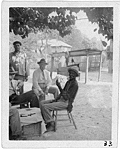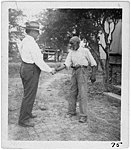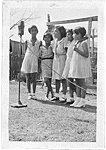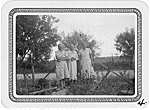
[Uncle Billy McCrea (right), with John A. Lomax (center), and friends, at Billy's home in Jasper, Texas]
(Library of Congress, Prints and Photographs Division. Reproduction number: LC-USZ62-120994)
John Avery Lomax was born in Goodman, Mississippi, on September 23, 1867, and grew up on the Texas frontier, just north of Meridian in rural Bosque County. A Texan at heart, if not by birth, his early years on the family farm accustomed him to the hard work that, along with a boundless energy, became a hallmark of his life and career.
For larger image, click on picture

[Uncle Billy McCrea (right), with John A. Lomax (center), and friends, at Billy's home in Jasper, Texas] (Library of Congress, Prints and Photographs Division. Reproduction number: LC-USZ62-120994) |
After teaching in rural schools for a few years, Lomax entered the University of Texas in 1895, specializing in English literature. In Adventures of a Ballad Hunter, he recounts the story of his arrival at the university with a roll of cowboy songs he had written down in childhood. He showed them to an English professor, only to have them discounted as "cheap and unworthy," prompting him to take the bundle behind the men’s dormitory and burn it.1 His interest in folksongs thus rebuffed, Lomax focused his attentions on more acceptable academic pursuits. After graduation, he worked at the University of Texas as registrar, manager of Brackenridge Hall (the men’s dormitory on campus), and personal secretary to the president of the university. In 1903, he accepted an offer to teach English at Texas A&M University and settled down with his new wife, Bess Brown Lomax, to what promised to be a quiet life in the country.
Bucolic country living did not suit Lomax for long, however: in 1907, he jumped at the chance to attend Harvard University as a graduate student. Here he had the opportunity to study under Barrett Wendell and George Lyman Kittredge, two renowned scholars who actively encouraged his interest in cowboy songs. This experience changed the course of Lomax’s life and work. Both Wendell and Kittredge continued to play an important advisory role in his career long after he returned to Texas the following year, Masters of Arts degree in hand, to resume his teaching position at A&M. Encouraged by Wendell, he applied for, and was awarded, a Sheldon grant to research and collect cowboy songs. The resulting anthology, Cowboy Songs and Other Frontier Ballads, was published in 1910 to critical and popular acclaim.
Around the same time, Lomax and Professor Leonidas Payne of the University of Texas co-founded the Texas Folklore Society, following Kittredge’s suggestion that Lomax establish a Texas branch of the American Folklore Society. Lomax and Payne hoped that the society would further their own research while kindling an interest in folklore among like-minded Texans. On Thanksgiving Day, 1909, Lomax nominated Payne as president of the society, and Payne nominated Lomax as secretary. The two set out to marshal support, and a month later, Killis Campbell, an associate professor at the university, publicly proposed the formation of the society at a meeting of the Texas State Teachers Association in Dallas. By April 1910, there were ninety-two charter members.
The society grew gradually over the next decade, with Lomax steering it forward. At his invitation, Kittredge and Wendell attended its meetings. Other early members were Stith Thompson and J. Frank Dobie, who both began teaching English at the university in 1914. At Lomax’s recommendation, Thompson became the society’s secretary/treasurer in 1915. In 1916, Thompson edited the first volume of the Publications of the Texas Folklore Society, which Dobie reissued as Round the Levee in 1935. This publication exemplified the society’s express purpose, and the motivation behind Lomax’s own work: to gather a body of folklore before it disappeared, and to preserve it for the analysis of later scholars. These early efforts foreshadowed what would become Lomax’s greatest achievement, the collection of more than ten thousand recordings for the Archive of American Folk Song at the Library of Congress.
In June 1910, Lomax accepted an administrative job at the University of Texas. Throughout the next seven years, he continued his research, and also undertook lecture tours, assisted and encouraged by his wife and children. All this came to an end in 1917, however, when Lomax was fired along with six other faculty members as the result of a political battle between Governor James Ferguson and the university president, Dr. R.E. Vinson. His academic career seemingly in ruins, Lomax moved to Chicago to accept a job as a banker. Shortly afterwards, Ferguson was impeached and the Board of Regents rescinded its dismissal of the faculty, but Lomax did not return to his former job. Instead, he divided the next fifteen years between banking and working with various University of Texas alumni groups. During that time, he did minimal song research; without ready access to a major library, most of the research he did do was through correspondence.
Tragedy struck the Lomax family in 1931, when Bess Brown Lomax died at the age of fifty, leaving four children (the youngest, Bess, only ten years old) and a devoted husband. The following year, in hope of reviving Lomax’s flagging spirits, John Lomax Jr. encouraged his father to begin a series of lecture tours. So the Lomaxes took to the road once again, with John Jr. (and later Alan) accompanying the senior Lomax as salesman, manager, and personal assistant. In June 1932, they arrived at the offices of the Macmillan publishing company in New York. Here Lomax proposed his idea for an all-inclusive anthology of American ballads and folksongs. It was accepted, and he traveled to Washington to review the holdings in the Archive of American Folk Song.
By the time of Lomax’s arrival, the Archive already contained a collection of commercial phonograph recordings and wax cylinder field recordings of folksongs, built up under the leadership of Robert Winslow Gordon, Head of the Archive, and Carl Engel, chief of the Music Division. Gordon had also developed and experimented in the field with a portable disc recorder. Lomax made an arrangement with the Library whereby it would provide recording equipment (including recording blanks), in exchange for which he would travel the country recording songs to be added to the Archive. Thus began a ten-year relationship with the Library that would involve not only John but the entire Lomax family, including his second wife, Ruby Terrill Lomax, whom he married in 1934. All four of John's children assisted with his folksong research and with the daily operations of the Archive: Shirley, who performed songs taught to her by her mother; John Jr., who encouraged his father's association with the Library; Alan, who accompanied John on field trips and in 1937 became the Archive’s first paid employee as Assistant in Charge; and Bess, who spent her weekends and school vacations copying song text and doing comparative song research.
Thanks to a grant from the American Council of Learned Societies, Lomax was able to set out in June 1933 on the first recording expedition under the Library’s auspices, with Alan (then eighteen years old) in tow.
For larger image, click on picture
 Trunk of car with recording equipment (Library of Congress, American Folklife Center) |
Lomax’s enthusiasm for the new recording technology greatly influenced his own collecting methodology. These relatively new devices allowed the singer’s own voice to be heard in every nuance and modulation, without, it was sometimes thought, the interference of the collector’s written interpretation. The machine assumed the role of stenographer, and because of its accuracy, some collectors paid little attention to secondary documentation.
In 1934, Lomax was named Honorary Consultant and Curator of the Archive of American Folk Song, and he secured grants from the Carnegie Corporation and the Rockefeller Foundation, among others, for continued field recordings. He and Alan recorded Spanish ballads and vaquero songs on the Rio Grande border and spent weeks among French-speaking Acadians in southern Louisiana.
For larger image, click on picture

[Uncle Rich Brown and John A. Lomax (left) at the home of Mrs. Julia Killingsworth near Sumterville, Alabama] (Library of Congress, Prints and Photographs Division. Reproduction number: LC-USZ62-56331) |
Lomax's contribution to the documentation of folk traditions extended beyond the Music Division through his involvement with two agencies of the Works Progress Administration. In 1936, he was assigned to serve as an advisor on folklore collecting for both the Historical Records Survey and the Federal Writers' Project. As the Federal Writers' Project's first folklore editor, Lomax directed the gathering of ex-slave narratives and devised a questionnaire for Project fieldworkers to use. This work was continued by Benjamin A. Botkin, who succeeded Lomax as the Project's folklore editor in 1938, and at the Library in 1939.
Lomax's involvement with the WPA brought him into contact with writers in the field, who in turn introduced him to a wider array of performers for his own song research. Two of these writers, Mrs. Genevieve Chandler, of Murrells Inlet, South Carolina, and Ruby Pickens Tartt, of Livingston, Alabama, were instrumental in forming the content of the folksong collection made in 1939. Thanks to Ruby Pickens Tartt’s extensive knowledge of her local community, for example, the Lomaxes were introduced to such singers as Dock Reed, Vera Hall, and Enoch Brown.
As Lomax continued his work, his field expeditions reflected his broadening scope of interest, as can be seen in the wide variety of genres recorded during the 1939 Southern States Recording Expedition. Lomax rarely wavered from his quest for old songs, however, taking advantage of the latest technologies to preserve the past. The materials in this collection reflect his unstinting effort to document cultural traditions that he saw as threatened by an encroaching modern world.
Footnotes:
1 John A. Lomax, Adventures of a Ballad Hunter (New York: Macmillan
Co., 1947), 32.
2 John A. Lomax, quoted in the 1933 annual report of the chief of the Division of Music, Carl Engel, in Archive of American Folk Song: A History 1928-1939. Library of Congress Project, Work Projects Administration, 1940, p. 24.
Born and raised in Denton, Texas, just outside of Dallas, Ruby Terrill earned degrees at state colleges, setting a record at the University of Texas at Austin for the highest grade average yet achieved by a woman at the university. Recognizing that education was her calling, she taught in rural and urban high schools and colleges in her home state, supporting herself while continuing her own studies. She worked toward a doctorate in classical languages by garnering a fellowship in Latin at the University of Texas for the year 1914-15 and taking summer courses for four years at the University of Chicago and two years at Columbia University.
For larger image, click on picture

Mexican girls, San Antonio, Tex. (Library of Congress, Prints and Photographs Division. Reproduction number: LC-USZ62-71616) |
In 1925, Terrill received an M.A. in classical languages from Columbia University, with a major in Latin and a minor in Greek, and soon after accepted the position of dean of women and associate professor of classical languages at the University of Texas at Austin. During her tenure at the university, she kept active in a variety of local, national, and international societies. Ever popular with the students and involved with both the faculty and the community, she was renowned for her sense of humor and gentle consideration.
As her education and career indicate, Ruby Terrill was an accomplished and progressive woman in her time. In 1929, she joined with eleven other Texas women educators to found The Delta Kappa Gamma Society International, an honorary society dedicated to advancing the professional interests and position of women in education. She was nominated parliamentarian, guiding the society procedurally for its first four years, and she eventually held a number of other positions, including first vice-president (1933). The twelve founders risked their hard-earned professional positions to create the society. It was frowned upon by their male and even some of their female colleagues, who felt that women’s organizations smacked of suffragism. Ruby Terrill continued to contribute her time, energy, and ideas to Delta Kappa Gamma long after her retirement from the university, and she left a gift to the society in her will. To this day, the boardroom at the society’s headquarters in Austin is named the Ruby Terrill Lomax Boardroom.
Ruby Terrill became the second Mrs. John A. Lomax in 1934. "Miss Terrill," as John Lomax called her even during their fourteen years of marriage, first met her future husband in 1921. She was dean of women and classical languages instructor at East Texas State Teachers College in Commerce, Texas, when John Lomax gave a lecture on his cowboy song research. After she gave him and his young son Alan a tour of Commerce, he enlisted her as a babysitter. Over a decade later, the widowed John Lomax met Miss Terrill again, at the University of Texas at Austin. An alumnus and former employee of the university, he was visiting this time in his role as a parent, and she was Alan Lomax’s Latin instructor.
Throughout the summer of 1933, while John and Alan Lomax toured the Southern states collecting folksongs, John courted Ruby Terrill by mail, engaging her interest while simultaneously describing to her his life’s work. Perhaps she saw an aspect of her passion for the classics in his passion for preserving near-extinguished American folk expressions; perhaps it was their mutual love for Texas that transformed their acquaintance into romance. After receiving the blessing of John Lomax’s two adult children, Shirley and John Jr., they announced their engagement at a grand fête in Austin on March 31, 1934. As "an event of statewide interest," it was reported in all of the major Texas newspapers the next day.1
John and Ruby Lomax married on July 21, 1934, in Commerce, Texas, the site of their first meeting. They honeymooned in the West, then resettled in Austin, where she resumed her duties at the university and assumed the new duties of parenting the Lomax teenagers, Bess and Alan, who affectionately called their stepmother "Deanie." She managed to teach and administer at the university, remain involved in myriad organizations, oversee the home and family, and take care of a number of duties for her husband’s research, while he resumed collecting, lecturing, and meeting with publishers and funders.
For larger image, click on picture
 Mrs. Minnie Smith, Mrs. Elizabeth Fulks, Mrs. Valbertina Kimball, at Mrs. Fulks' home in Stanton, Texas (Library of Congress, Prints and Photographs Division. Call number: LOT 7414-F, no. N22) |
In 1937, she exchanged the academic pursuits and frenetic schedule of her life in Austin for the intellectual pursuits and equally frenetic pace of life on the road with a ballad hunter. The Lomaxes moved to the "House in the Woods" outside Dallas as their permanent residence, then drove away in her Plymouth on a scouting tour of the Southern states. It was Ruby Lomax’s first trip in the capacity of "chauffeur, valet, buffer, machine operator, disk-jockey, body-guard, doctor and nurse, wife and companion," a role she would reprise on later occasions, including the 1939 Southern States Recording Trip.
Ruby Terrill Lomax’s role in the success of the 1939 Southern States Recording Trip cannot be overemphasized. Nearly all written documentation relating to the collection was composed by her. Read her notes on the records’ dust jackets, her transcriptions of song texts, and her. In addition, her voice can be heard on a number of the recordings, carefully announcing the performer’s name and the date and location of the recording.
Ruby Terrill Lomax's contributions extended to photography, as well. She was responsible for some of the photographs taken during a 1940 recording expedition.
John Lomax’s May 12, 1939 letter to Music Division chief Harold Spivacke highlights his wife’s volunteer contributions to the Library’s Archive of American Folk Song: "In nearly every instance Miss Terrill is including typed copies of the words contained on each record; also the slang of the song and the singers. This will be a big saving for the Library. Writing down the words from the record playing is a long, tedious job."3 While her husband possessed the contacts, the title of Honorary Consultant and Curator of the Archive of American Folk Song, and the expert knowledge of the material he was seeking and collecting, Ruby Lomax possessed the organizational and archival skills of a longtime administrator and instructor, the wide-eyed wonder of a lifelong learner uncovering a whole new world of studies, and the social skills of a parliamentarian who was a key player on many teams.
After John Lomax’s death in 1948, Ruby Lomax remained at the "House in the Woods" for many years. She died at the age of seventy-five on December 28, 1961, at the Christian Home for the Aged in Houston, Texas, and is buried in Grove Hill Memorial Park in Dallas. Her legacy lives on in the Delta Kappa Gamma Society International and other progressive organizations to which she contributed, as well as in the Library of Congress, where reside the thousands of songs and stories that she collected and documented alongside her eminent husband.
Footnotes:
1 Fort Worth Star-Telegram, 1 April 1934, quoted in Nolan A. Porterfield, Last Cavalier: The
Life and Times of John A. Lomax, 1867-1948 (Urbana: University of Illinois Press, 1996), 320.
2 Ruby Terrill Lomax, "Adventures with the Ballad Hunter," draft manuscript of a talk given before the Dallas Philological Society, Dec. 1950, quoted in Porterfield, Last Cavalier, 402.
3John A. Lomax to Harold Spivacke, May 12, 1939.
 Library of Congress
Library of Congress